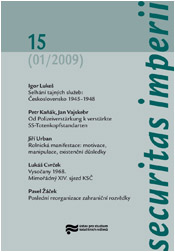Od Polizeiverstärkung k verstärkte SS-Totenkopfstandarten.
From Polizeiverstärkung to verstärkte SS-Totenkopfstandarten.
Evolution and implementation of some repressive SS forces, 1933–1941
Author(s): Petr Kaňák, Jan VajskebrSubject(s): Military history, Interwar Period (1920 - 1939), WW II and following years (1940 - 1949), Fascism, Nazism and WW II
Published by: Ústav pro studium totalitních režimů
Keywords: SS-Totenkopfstandarten; SS forces
Summary/Abstract: The units known as Polizeiverstärkung and later verstärkte SS-Totenkopfstandarten were a transitional stage in the evolution of armed SS divisions. Their importance to the Reichsfuhrer-SS Heinrich Himmler was based on their independence from the army and the police. Another important element in their existence was the fact that they effectively operated in a legal vacuum and enabled the SS to purposely sidestep the army, which had obstructed the development of armed SS divisions. In the first half of the 1930s, they were formed as a means of ensuring the internal political pacification of Germany in the event of a military conflict, but in view of the general widening of the role of the SS in Nazi expansion plans, they were given newly formulated objectives in 1939. Officially, they were identified as policing divisions and most of them were employed as occupant units safeguarding German interests in occupied territories. In occupied Poland, they even participated in the first extermination operations. From the autumn of 1939 to the summer of 1940, the verst. SS-Totenkopfstandarten also comprised the predominant part of SS forces in the Protectorate of Bohemia and Moravia. Initially, these “police reinforcements” were primarily meant to ensure the security of industrial enterprises and arms transports to the Reich. Nevertheless, they soon assumed responsibility for guarding German administrative and police authorities in Bohemian and Moravian capital cities and they simultaneously fulfilled a representative role. Despite a lack of personnel and material equipment, they also comprised a strong auxiliary force in the case of extraordinary events. Their most signifi cant action in this role took place on 17 November 1939 when they occupied university buildings and were also responsible for the execution of student leaders who were arrested. Although the verst. SS-Totenkopfstandarten were eventually used for policing purposes, they never became part of the German police corps. The ambitions of the SS extended further and, from the outset, the SS-T.St. were trained as military units even though they were never used for combat purposes throughout their existence in the years 1939 – 1940. Moreover, the Wehrmacht did not recognise service in these divisions as the fulfilment of compulsory military service. After the creation of the Waffen-SS, the verst. SS-Totenkopfstandarten gradually became superfluous. Consequently, they began to be disbanded in 1940 as part of extensive changes in the organisational structure of the Waffen-SS. As such, they were partly dissolved and their potential was used to augment existing units or to create new ones. The remainder were transformed into motorised infantry regiments and included in the formation of SS brigades and divisions. The reorganisation reflected the general trend in the development of the Waffen-SS, i.e. its conversion into a powerful military force (even though a number of SS units continued to be used exclusively for repressive purposes). In Germany and the occupied territories, including the Protectorate of Bohemia and Moravia, the verst. SS-Totenkopfstandarten were replaced by specialised divisions. The training of recruits continued to be provided by replacement battalions for individual SS regiments and buildings were watched by newly created SS guard battalions.
Journal: Securitas imperii
- Issue Year: 2009
- Issue No: 15
- Page Range: 42-97
- Page Count: 56
- Language: Czech

